
Scythropia crataegella, the hawthorn moth, is a species of moth in the family Plutellidae from western Eurasia. It is usually placed in a small subfamily Scythropiinae, which is sometimes included in the Yponomeutinae of the Yponomeutidae.

Hedya salicella is a moth of the family Tortricidae. It is found in Europe.

Hedya nubiferana, the marbled orchard tortrix or green budworm moth, is a moth of the family Tortricidae. It is found in the Palearctic and Nearctic realms.
Coleophora coracipennella is a moth of the family Coleophoridae. The species is found in Europe and was first described by Jacob Hübner in 1796.

Kocakina is a genus of moths of the family Noctuidae. It contains only one species, Kocakina fidelis, the intractable quaker moth, which is found in North America, where it has been recorded from Quebec and Maine to Florida, west to Texas and Kansas. The habitat consists of dry woodlands. The former genus name, Himella, is a junior homonym, and was replaced by Kocakina in 2006.

Hedya is a genus of moths belonging to the subfamily Olethreutinae of the family Tortricidae.

Epinotia signatana is a moth of the family Tortricidae. It is found from England and Scandinavia to the Mediterranean Sea, to eastern Russia, China, Korea, Burma and Japan.
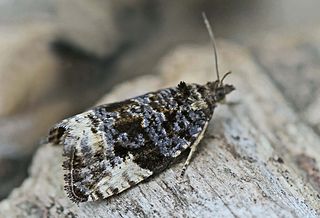
Hedya pruniana, the plum tortrix, is a species of moth of the family Tortricidae. It is found in the Palearctic realm. In central Europe, it is a common species. In the east, the range extends through Anatolia and Iran, the Ural, Transcaucasia and western Kazakhstan to the Far East.

Pandemis cinnamomeana is a moth of the family Tortricidae. It is found from Europe to Russia, China, Korea and Japan.
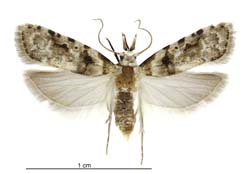
Coscinoptycha improbana, the Australian guava moth, is a moth of the family Carposinidae and only member of the genus Coscinoptycha. It is native to Australia, where it is found from Eungella in Queensland down through New South Wales, Victoria and Tasmania. It also occurs on Norfolk Island and has been recorded from New Zealand since 1997. The presence of this species has also been detected in New Caledonia in 2012.
Athrips rancidella, the cotoneaster webworm, is a moth of the family Gelechiidae. It is found in most of Europe, except Ireland, the Netherlands, Fennoscandia and the Baltic region. It has also been recorded from Syria, Turkmenistan, Tajikistan and the United States.

Carpatolechia fugitivella, the elm groundling, is a moth of the family Gelechiidae. It is found in almost all of Europe, Turkey, the Caucasus, Mongolia, southern Siberia, the Russian Far East and Korea. It is also found in Canada, where it has been recorded from Ontario and Quebec. The habitat consists of woodland, parks, gardens and hedgerows.
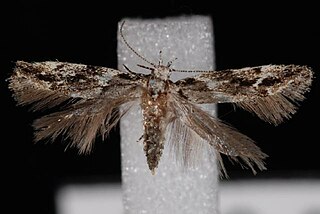
Recurvaria nanella, the lesser bud moth, is a moth of the family Gelechiidae. It is widely distributed in Europe and is also found in Turkey, the Near East, North Africa, the Caucasus, Transcaucasia, Kazakhstan and south-eastern Siberia. It is also found in North America, where it is probably introduced.
Archips fuscocupreanus, the exotic leafroller moth or apple tortrix, is a species of moth of the family Tortricidae. It is found in China, South Korea, Japan and Russia. It is an introduced species in the north-eastern United States, where it has been recorded from Connecticut, Massachusetts, New Jersey, New York and Rhode Island. It has also been recorded from Washington.
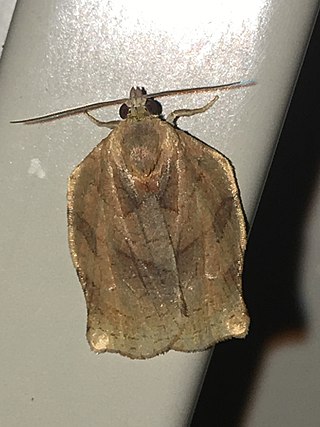
Archips purpuranus, the omnivorous leafroller moth, is a species of moth of the family Tortricidae. It is found in most of eastern North America.
Argyrotaenia quadrifasciana, the four-lined leafroller moth, four-banded leafroller or lesser all-green leafroller, is a species of moth of the family Tortricidae. It is found in North America, where it has been recorded from Nova Scotia to West Virginia, west to Arkansas and north to Alberta. The habitat consists of orchards and shrubby areas.

Choristoneura longicellanus is a species of moth of the family Tortricidae. It is found in China, Japan, Taiwan, the Korean Peninsula and the Russian Far East.
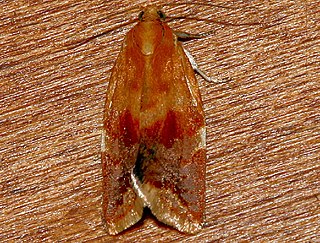
Clepsis persicana, the white triangle tortrix or the green needleworm, is a species of moth of the family Tortricidae. It is found in North America, where it has been recorded from Alaska and British Columbia to Newfoundland and south to Virginia and west to California. The habitat consists of coniferous and mixed coniferous forests.
Pandemis pyrusana, the apple pandemis or pandemis leafroller moth, is a species of moth of the family Tortricidae. The species was first described by William D. Kearfott in 1907. It is found in North America, where it has been recorded from Alberta to British Columbia, south through Idaho, Utah and Colorado and California. The habitat consists of forests with deciduous trees and shrubs.
Acleris paracinderella is a species of moth of the family Tortricidae. It is found in North America, where it has been recorded from California.














